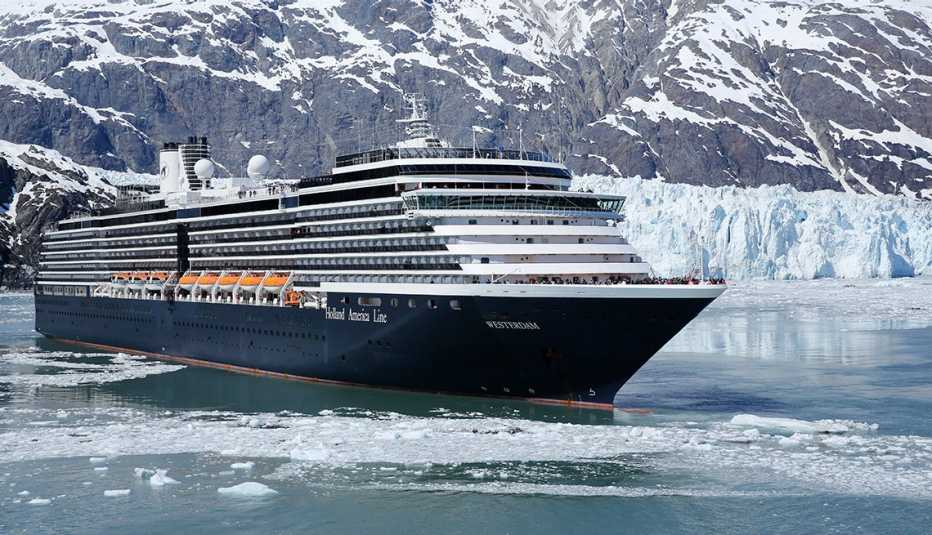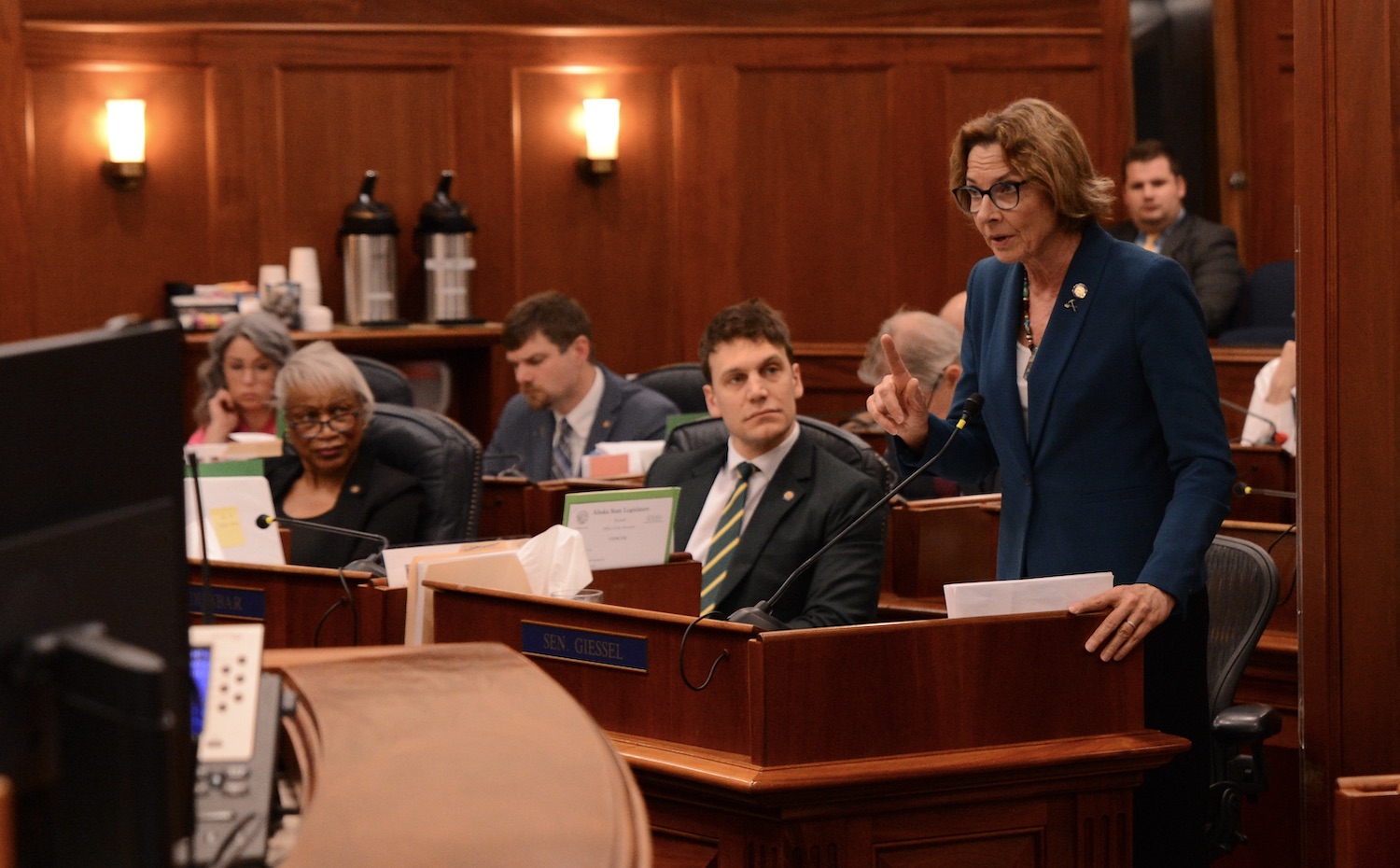
Jill Schildhouse enjoys the view from her balcony aboard the Windstar Star Legend.
Jill Schildhouse

Because Alaska’s cruise season is so short and demand is high — the projected count for 2023 is 1.65 million cruise travelers on 60 large and small ships sailing around 700 voyages, according to Cruise Lines International Association Alaska — prime cabins and itineraries can sell out six months in advance.
“If you want the best ship location and promotions, then book early,” says Reuling, noting she booked her upcoming Alaska cruise a year out. “As with all cruises, the most expensive and least expensive tend to sell out first.”

Jill Schildhouse enjoys the view from her balcony aboard the Windstar Star Legend.
Jill Schildhouse
Speaking of prime cabins, while you can easily get away with an inside or an ocean-view cabin on most cruises to save money, you’ll definitely want to splurge for a balcony in Alaska. Why? The vast majority of your route will be breathtakingly scenic, with nonstop opportunities to see whales and other marine life, chunks of ice, waterfalls, bald eagles and more. Your own private balcony (paired with a trusty set of binoculars) is always the best viewing spot on the ship. And with about 22 hours of daylight on cruises during the summer months, consider this round-the-clock viewing window your free excursion.
Small ship and big ship Alaska cruises both offer specific benefits, and understanding those differences will make or break your vacation.
Smaller ships — such as those on Windstar Cruises, UnCruise Adventures, Crystal Cruises, Seabourn Cruise Line and Hurtigruten Expeditions — can get up close and personal with glaciers and wildlife, sneaking into areas larger ships simply can’t fit into. The ships also are likely to have more remote port stops (such as Sitka or Nome), which gives you greater access to Alaska’s many cities. Additionally, smaller ships usually offer more in terms of education and are often staffed with naturalists and marine biologists who give lectures, answer questions and join passengers on Zodiac – inflatable boat – excursions. Finally, many of the smaller cruise ships tend to be more luxurious in terms of accommodations and cuisine, and some include alcohol and excursions in the cost of your booking.


Holland America offers big-ship cruising in Alaska.
Holland America Line
On the flip side, ships that hold several thousand passengers — such as those on Princess Cruises, Holland America Line and Norwegian Cruise Line — offer more onboard amenities. For example, Princess Cruises offers boutique fitness classes from Pure Barre, StretchLab, Club Pilates and CycleBar; Holland America’s Pinnacle-class ships (such as the Koningsdam, Nieuw Statendam and Rotterdam) have a bi-level spa with ergonomic ceramic heated loungers and a jetted Hydropool with swan neck jets to help relieve sore joints and aching muscles; and Royal Caribbean’s Ovation of the Seas has a FlowRider surf simulator and rock climbing wall. Large ships also have more live theater and entertainment options, a larger selection of excursions in each port and a greater array of dining venues.
But all of those extras certainly don’t mean you’ll lack in enrichment and education experiences if you choose a larger ship. My recent Princess cruise featured an onboard national park ranger the entire day we spent in Glacier Bay National Park & Preserve and various cultural heritage guides who shared Alaska Native traditions and storytelling.


FAIRBANKS, Alaska (KTVF) – The Centers for Disease Control and Prevention (CDC) reported an increase in overdose deaths within the state of Alaska despite the national decrease reported for 2023.
According to the CDC, reported overdose deaths in 2022 totaled 247 which rose to 356 in 2023. The state showed an estimated 44% increase, ranking the highest out of all 50 states. Opioids were the leading drug class, causing about 70% of the drug overdose deaths in the state.
As for the national data, it showed a decrease in overdose deaths, thus exhibiting progress. The CDC, along with their partners, have coordinated federal efforts for prevention, services and harm reduction. This was a part of the Biden Administration’s Overdose Prevention Strategy aimed at treating addiction and saving lives.
However, the data CDC reported shows 100,000 lives lost just last year to drug overdoses. The CDC has stated they are committed to doing what they can to end this epidemic and prevent unnecessary death and suffering.
The full report with data from the CDC can be accessed here.
Copyright 2024 KTVF. All rights reserved.

A late-session attempt to salvage a proposal that would revive public employee pensions in Alaska died on Tuesday. A simple bill aimed at attracting and retaining more teachers briefly became a vehicle to get the Senate-approved pension program to the House floor.
The Senate approved a pension bill in January that didn’t advance in the House, and there hasn’t been a public sign that the House majority has had a change of heart.
Senate Majority Leader Cathy Giessel, R-Anchorage and the pension bill’s sponsor, introduced the bill’s language as a 52-page amendment to the education bill. The Senate narrowly approved the addition, but Giessel rescinded the amendment after a break.
“It didn’t seem that it was going to make for a productive end to the session,” she said on Tuesday evening after the Senate gaveled out for the day.
Her proposal for a “defined benefit” retirement system has long been a priority of unions and many lawmakers who see it as a means to address high vacancy rates for state jobs.
She said the chance that the pension reboot becomes law this year is “probably zero — but that doesn’t mean it’s not a critical issue, especially for our workforce.”
The reversal came after pushback from the Senate’s pension bill opponents.
Sen. James Kaufman, R-Anchorage, opposed the amendment because he thought it threatened the education bill, which he supports. “The only thing it achieves is crushing the underlying bill,” he said.
House Bill 230 would allow teachers interested in Alaska careers to be compensated for more of their previous experience by eliminating a cap on how many years of out-of-state teaching would be considered when setting salaries.
Rep. Rebecca Himschoot, I-Sitka, proposed the bill. She said the cap is a potential barrier to attracting teaching talent to the state.
Members of the Senate added language that allows an increase in the number of consecutive days a retired teacher may work as a substitute, a change Senate Education Committee Chair Löki Tobin said is crucial to dealing with the state’s teacher shortage because it would allow districts to use qualified teachers while they find permanent hires. There were more than 500 vacant teaching positions at the beginning of this school year.
Lawmakers also approved incentives for teachers with national board certification, an amendment that mirrors a proposal from Sen. Jesse Bjorkman, R-Nikiski.
Töbin urged support for the bill. “It empowers school districts to compete for teachers who are coming from out of state. There’s a growing body of evidence that shows that good and experienced teachers increase student achievement,” she said.
Senators passed the bill with unanimous support; it returns to the House for agreement on the changes.
:quality(70)/cloudfront-us-east-1.images.arcpublishing.com/adn/LJ7MFWVFDNFMZOWCLIRZBOQ73Q.jpg)
Updated: 2 hours ago Published: 2 hours ago
The two largest credit rating firms issued positive reports for Alaska’s state government this spring, noting growing state budget reserves and progress on future North Slope oil projects.
S&P upgraded Alaska’s rating, while Moody’s revised the state’s rating outlook from stable to positive on April 30.
Credit ratings affect how much it costs the state government to borrow money and act as a thermometer for the health of state finances.
“It signals to the market that there’s economic activity and interest in the state,” said Adam Crum, commissioner of the state Department of Revenue.
Crum said after a previous credit rating improvement, an oil company told state officials their investors felt Alaska was a safer investment.
“We’ve heard for like 10 or 12 years, Alaska’s on the decline — we are a little bit, on the population side. But we’re starting to see a growth in the long-term picture of economic activity that we want the market to see,” Crum said. “And we want to get this like a snowball, and it gets bigger and bigger with more investment.”
The state’s credit ratings deteriorated between 2016 and 2020, then stabilized and are now improving.
In a credit opinion May 6, Moody’s Investor Services staff noted that Alaska’s Constitutional Budget Reserve grew over the past two years and the state expects it to grow modestly in the future, though it remains much smaller than it was a decade ago. The CBR is the state’s largest savings account, other than the Permanent Fund.
While the Moody’s report was largely positive, it pointed out some reasons for concern: While Alaska has kept draws from the Permanent Fund within the limit in state law, how those draws are divided between state operating expenses and Permanent Fund dividends remains unsettled.
And Alaska remains vulnerable to changes in the global oil market.
“While we may not want to implement new taxes or revenue streams, defining some of our large expenditures a little bit more clearly and a little bit more predictably are some of the things that can help us in the long term,” Crum said.
S&P upgraded Alaska to AA, its third-highest rating level, from AA-. Moody’s maintained Alaska at its fourth-highest rating level, Aa3, while changing the outlook from stable to positive.
Originally published by the Alaska Beacon, an independent, nonpartisan news organization that covers Alaska state government.


House Dems seeking re-election seemingly reverse course, call on Biden to 'bring order to the southern border'


Stand-in Jose Raul Mulino wins Panama presidential race


Compass Direct LLC’s 2024 Registration in North Carolina


UCLA to resume in-person classes after Gaza protest crackdown


Tech compliance reports, Newsletter


Columbia University cancels its main commencement ceremony after weeks of turmoil


Man, 75, confesses to killing wife in hospital because he couldn’t afford her care, court documents say


Pentagon chief confirms US pause on weapons shipment to Israel